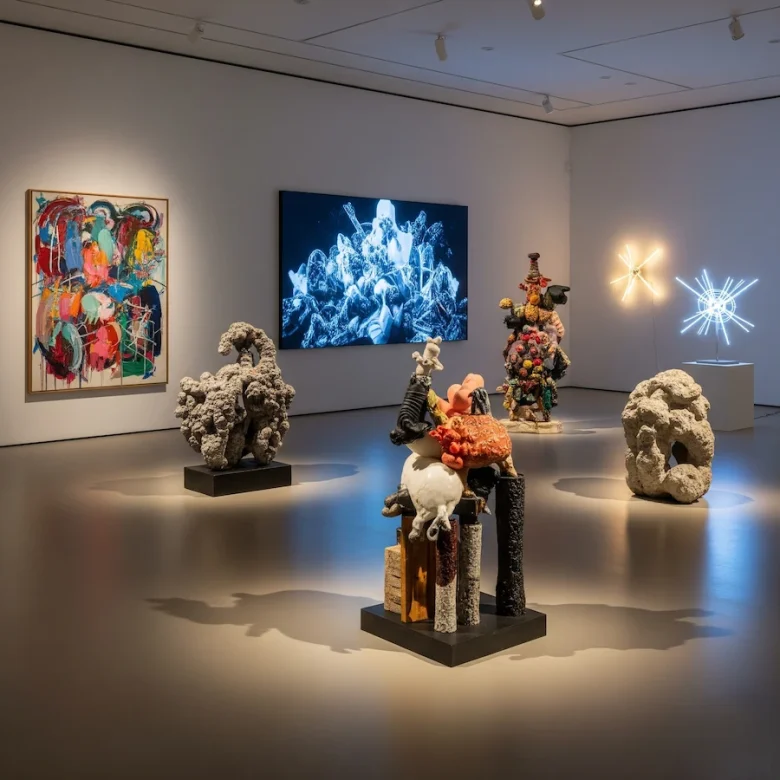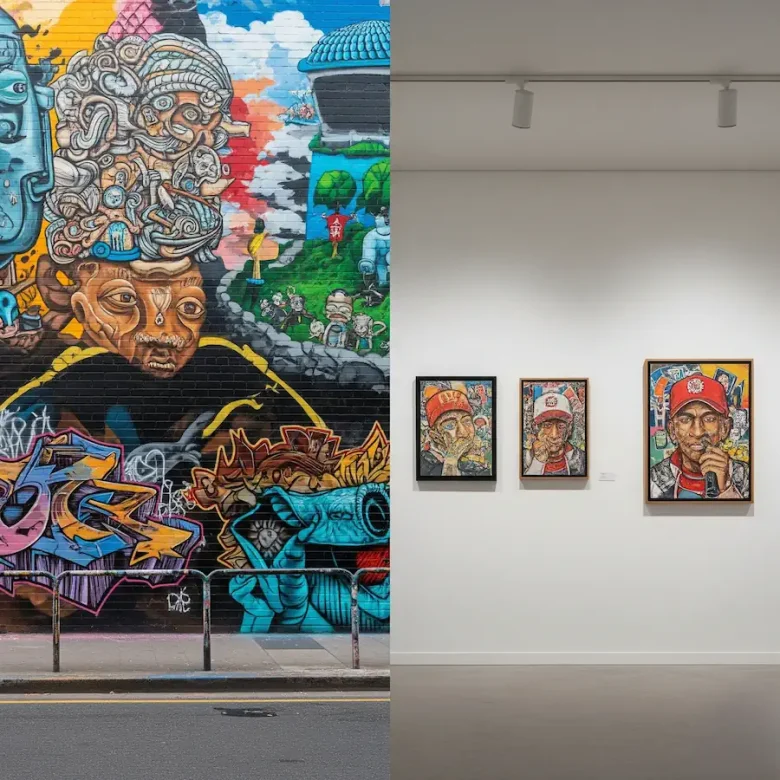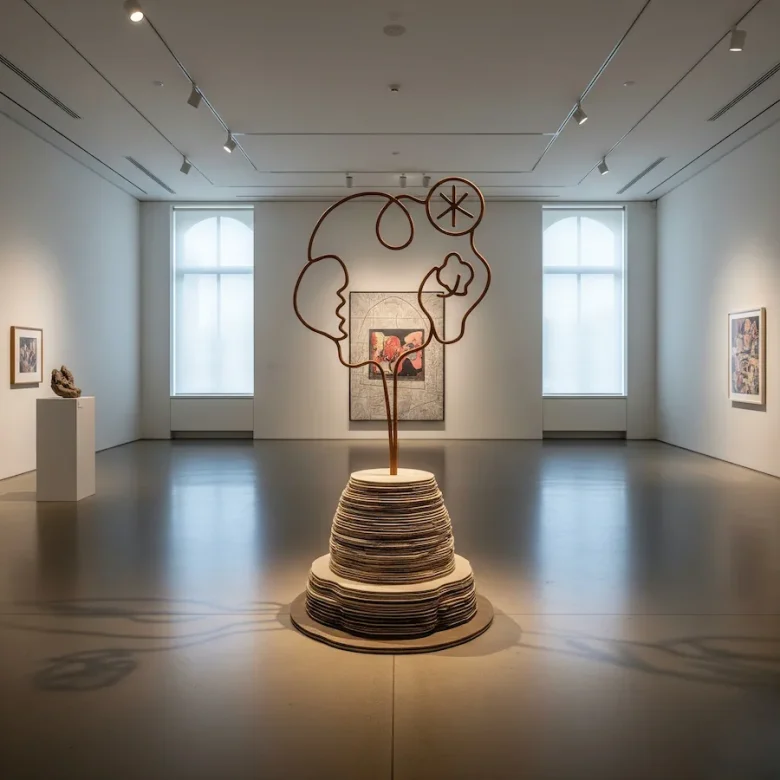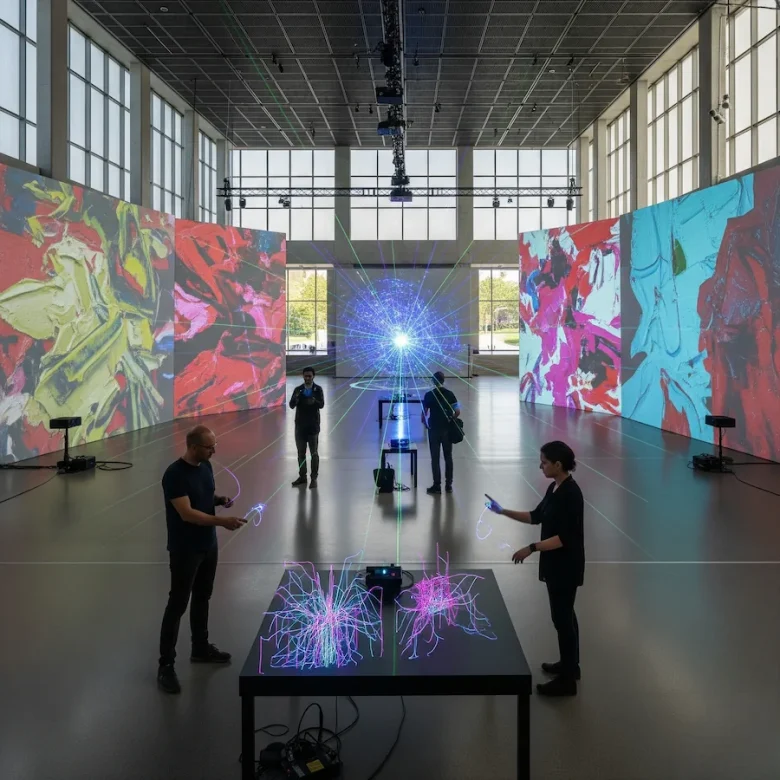The canvas of contemporary art is a vibrant, ever-evolving landscape, a testament to boundless creativity and daring expression. Far from being a static realm, it pulsates with the energy of artists who continually challenge conventions, spark dialogues, and redefine what art can be.
These aren’t just creators of beauty; they’re keen observers, critical thinkers, and sometimes, provocative disruptors who reflect and shape our modern world.
In an era marked by rapid technological advancement, shifting social paradigms, and global interconnectedness, contemporary artists serve as crucial interpreters, holding a mirror to our collective consciousness and inviting us to see the familiar in new, often startling, ways.
This article invites you on a journey through the studios and minds of some of the most famous contemporary artists. We’ll delve into their groundbreaking practices, explore the movements they lead, and understand the profound impact they have on global culture.
From monumental sculptures that redefine public spaces to intimate performances that challenge personal boundaries, and from digital creations that push the limits of perception to paintings that resonate with timeless human experience, these artists are at the forefront of creative innovation.
Prepare to be inspired by the visionaries who are painting, sculpting, and performing the narrative of our time, leaving an indelible mark on the history of art and influencing generations to come.
Defining contemporary art: more than just “new”
Understanding contemporary art is crucial to appreciating the artists who define it. It’s a term often used loosely, sometimes conflated with modern art, or simply seen as “art made recently.”
However, it’s a distinct period marked by specific characteristics and a profound engagement with the present moment, reflecting the complexities and nuances of our globalized society.
What sets contemporary art apart?
Contemporary art generally refers to art produced from the 1970s or 1980s to the present day. This timeframe signifies a significant shift from the preceding modern art movements.
While modern art focused on abstraction and autonomy, contemporary art emphasizes immense diversity in mediums, styles, and concepts. Unlike earlier movements defined by a singular “ism,” contemporary art thrives on pluralism, often defying easy categorization.
It’s a mirror reflecting our complex, globally influenced, and technologically advancing world, embracing myriad perspectives.
The breadth of materials and approaches is striking: from recycled plastic to social media platforms, genetic material to live performance. Boundaries between disciplines blur, and the definition of “art” is perpetually renegotiated.
This openness allows for dynamic interplay with science, philosophy, technology, and social studies, leading to rich, multi-layered artworks.
Moreover, contemporary art embraces a more inclusive and global perspective, moving beyond Eurocentric focuses to incorporate voices and aesthetics from every continent, enriching the art form into a truly universal language.
The art world itself is more interconnected, with international biennials and online platforms amplifying the reach of famous contemporary artists.
Key characteristics and themes
The defining features of contemporary art make it compelling and challenging, forming a rich tapestry of artistic inquiry.
Diversity and experimentation
This is paramount. Contemporary artists use a vast array of materials—traditional paint, digital media, found objects, even the human body in performance art.
Techniques range from classical craftsmanship to advanced computational methods, pushing production boundaries and ensuring innovation. This boundless approach means viewers are constantly surprised by unexpected forms.
Conceptual depth
Often, the idea behind the artwork is as important as its aesthetic form. Contemporary art frequently invites intellectual engagement.
Its power lies in complex ideas explored—human psychology, political systems, environmental degradation, the nature of reality. Understanding context enhances the experience, often requiring active viewer participation.
Engagement with current issues
Contemporary artists are deeply embedded in their time, acting as a barometer of societal concerns and a catalyst for discussion. Themes commonly explored include:
- Identity: Examining personal, cultural, gender, and sexual identities, grappling with intersectionality and self-definition.
- Globalization: Reflecting on interconnectedness, cultural exchange, and migration.
- Technology: Exploring the pervasive influence of digital media, AI, and VR on human experience.
- Social justice: Addressing inequality, human rights, and power dynamics.
- Environmental concerns: Highlighting climate change and humanity’s relationship with nature.
- Political commentary: Offering critiques of systems and societal challenges, giving voice to dissent.
Breaking boundaries
Contemporary art consistently blurs disciplinary lines. Installations merge science, performances draw from theater or music. It challenges traditional notions of what constitutes art, where it’s displayed, and who can be an artist.
This fluidity creates new possibilities for expression, making art more accessible and relevant. Multidisciplinary practices often involve collaborations with scientists, technologists, and architects, fostering groundbreaking, immersive experiences.
Iconic figures: the pioneers and powerhouses

Within contemporary art, certain artists have achieved widespread recognition not just for technical prowess, but for pushing boundaries and resonating globally. These famous contemporary artists define their era’s aesthetic and intellectual currents.
Jeff Koons:
Born in 1955, Koons is known for monumental sculptures blurring high art, popular culture, and kitsch. He appropriates everyday objects, transforming them into meticulously crafted, highly polished, often gigantic pieces.
His “Balloon Dog” series elevates a simple party favor to a multi-ton stainless steel sculpture selling for millions, reflecting on consumerism and celebrity.
Koons’s production methods, involving large teams, raise questions about authorship and art’s industrialization. Despite critical debate, his works command record-breaking prices, cementing his status as one of the most influential, wealthy, and controversial famous contemporary artists.
Damien Hirst
A leading Young British Artist (YBA), Hirst (born 1965) is famous for provocative works on death, beauty, and commerce. His iconic pieces include animals preserved in formaldehyde, like “The Physical Impossibility of Death in the Mind of Someone Living” (a tiger shark).
He also created the diamond-encrusted skull “For the Love of God” and vibrant “spin paintings.” Hirst consistently pushes art’s boundaries, forcing viewers to confront mortality. His work is often controversial, sparking debates on ethics and commercialization, yet his impact on contemporary art and market navigation are undeniable.
Ai Weiwei
Born in 1957, Ai Weiwei is a Chinese conceptual artist and outspoken activist recognized for large-scale installations and critiques of human rights abuses and censorship.
His work addresses political issues, freedom of expression, and refugee plights. “Sunflower Seeds” (2010), millions of porcelain seeds filling Tate Modern’s Turbine Hall, highlighted mass production and individualism.
He uses traditional Chinese craftsmanship to comment on modern global issues, blending heritage with urgent concerns. His activism, including detention by Chinese authorities, makes him a global symbol of artistic resistance and a powerful voice for change, positioning him as one of the most politically significant famous contemporary artists.
Masters of diverse mediums

These artists demonstrate exceptional versatility, redefining medium use and showcasing contemporary art’s expansive possibilities.
Yayoi Kusama
The Japanese artist Yayoi Kusama (born 1929) is a global icon known for polka dots, net patterns, pumpkin sculptures, and immersive “Infinity Mirrored Rooms.” Her work delves into obsession, infinity, and self-obliteration, often stemming from lifelong mental illness.
Her “Infinity Mirrored Rooms” create boundless spaces, highly sought after globally for their unique, visually stunning, and contemplative experience.
Kusama’s long career and prolific output across diverse mediums have cemented her status as one of the most beloved, recognizable, and commercially successful famous contemporary artists.
Gerhard Richter
Born in 1932, Gerhard Richter is a German visual artist widely considered one of the most important living painters. His practice is remarkably versatile, from photorealistic paintings (often blurred) to large-scale abstract works, and glass installations.
Richter constantly challenges perceptions of reality and painting’s nature. His “blur” technique softens details, making images appear like memories, questioning objective truth.
His abstract works, built in layers then scraped away, explore color, texture, and gesture. Richter’s philosophical approach and continuous reinvention make him a towering, influential figure in contemporary art, with his works achieving some of the highest prices for a living artist.
David Hockney
A prominent figure in the Pop Art movement of the 1960s, David Hockney (born 1937) remains one of the most influential and innovative famous contemporary artists.
The British painter is celebrated for vibrant landscapes, intimate portraits, and innovative use of new media. He captured Los Angeles’s sun-drenched atmosphere in his iconic swimming pool paintings.
In recent years, Hockney embraced digital technology, creating vivid landscapes and portraits using iPads, showcasing continuous experimentation.
His cheerful palette and optimistic outlook contrast with some of contemporary art’s somber themes, making his work widely appealing and relevant.
Street art to galleries: global voices and urban narratives

The democratization of art has seen artists emerge from unconventional spaces, bringing diverse perspectives and often politically charged messages. This shift challenges traditional gatekeepers, bringing contemporary art directly to the public.
Banksy: the enigmatic activist
No famous contemporary artist embodies this shift more profoundly than Banksy. The anonymous British street artist, activist, and filmmaker gained global fame through satirical stencil art.
His works appear overnight in public spaces—walls, bridges—offering poignant social and political commentary on anti-capitalism, consumerism, and global issues with sharp wit.
His elusive identity adds to his mystique, allowing his message to take center stage, free from personality cults. Beyond street art, Banksy executes high-profile stunts manipulating the art market and media.
The famous example is his “Girl with Balloon” self-shredding after selling at Sotheby’s, sparking global conversations on art’s value and destruction (renamed “Love is in the Bin”).
His audacious actions bypass traditional gallery systems, making art directly accessible and proving impactful contemporary art doesn’t always reside in museums; it can exist anywhere.
Jean-Michel Basquiat: a legacy of urban expression
Though his career was tragically short (died at 27 in 1988), Jean-Michel Basquiat remains one of the most influential, iconic, and famous contemporary artists.
Born in Brooklyn in 1960, he emerged from New York City’s vibrant street art scene, gaining notoriety as “SAMO©,” tagging cryptic messages.
He transitioned to the gallery world rapidly, becoming an international sensation in the 1980s, notably collaborating with Andy Warhol.
His raw, expressive paintings fused graffiti, abstract expressionism, text, and imagery from diverse sources (African art, jazz, cartoons).
Basquiat powerfully addressed race, class, identity, and systemic oppression, depicting powerful Black figures to challenge the predominantly white art historical canon.
His spontaneous energy, intellectual depth, and poignant social critique created a unique visual language. Basquiat’s meteoric rise and tragic death solidified his mythical status, and his work continues to break auction records, profoundly influencing artists exploring identity and urban life.
Contemporary art’s embrace of identity and social commentary

One of contemporary art’s most powerful aspects is its capacity to explore identities, challenge norms, and shed light on critical social issues.
Many famous contemporary artists use their voices to foster dialogue, provoke empathy, and advocate for social change, making their art deeply relevant.
Kehinde Wiley: Redefining Portraiture
Kehinde Wiley (born 1977) is an American artist celebrated for vivid, large-scale portraits of African Americans in classical, heroic poses. Wiley recontextualizes historical portraiture to challenge stereotypes and celebrate Black identity.
He finds subjects on the street, inviting them to pose like iconic historical figures, critiquing the historical exclusion of Black bodies from grand portraiture.
His paintings are meticulously detailed, combining hyperrealistic figures with rich, ornate, vibrant backgrounds featuring intricate patterns.
This fusion creates a powerful juxtaposition, granting dignity and gravitas to marginalized individuals. His work directly confronts representation, race, and identity construction.
Wiley gained international recognition painting President Barack Obama’s official portrait for the National Portrait Gallery, a cultural moment cementing his status as one of the most important famous contemporary artists today.
Kara Walker: confronting history through silhouettes
Kara Walker (born 1969) is an American contemporary artist whose provocative silhouette installations, cut-paper pieces, and films delve into complex themes of race, gender, sexuality, and violence within American history.
Her work draws on narratives of slavery and the American South, reimagining them with a fantastical, grotesque lens to expose uncomfortable truths and the enduring legacy of racial trauma.
Walker’s signature use of large-scale black-cut paper silhouettes, a traditional craft, is subverted to depict exaggerated figures in graphic, unsettling scenarios.
These narratives are ambiguous, forcing viewers to confront their own biases. “A Subtlety, or the Marvelous Sugar Baby” (2014), a massive sugar sphinx sculpture, addressed slavery, labor exploitation, and racialized female bodies.
Her work challenges viewers to grapple with history and power, making her an essential voice among famous contemporary artists who compel society to reckon with its past.
The evolution of form: abstraction, installation, and beyond

Contemporary artists relentlessly push traditional art forms, embracing new abstraction methods, creating immersive installations, and leveraging cutting-edge technologies to redefine what art can be and how it’s experienced. This constant innovation reflects a desire to engage viewers profoundly.
Julie Mehretu: dynamic abstractions of our world
Julie Mehretu (born 1970) is renowned for monumental, large-scale abstract paintings resembling complex maps or diagrams of global forces. Her canvases are vibrant, multi-layered compositions, often beginning with airbrushed photographic elements or architectural renderings, over which she applies intricate mark-making.
The works are dynamic vortexes evoking urban landscapes, globalized networks, and socio-political events, reflecting modern life’s organized chaos.
Mehretu’s work explores migration, identity, history, and globalization’s impact, embedding narratives of specific historical events and shifts within her abstract forms. Her paintings are intellectual propositions, inviting viewers to decipher layers and contemplate forces shaping societies.
The scale often envelops the viewer, drawing them into a dense visual field. Her ability to imbue abstract painting with profound conceptual depth and relevance has solidified her position as one of the most compelling famous contemporary artists in abstraction today.
Anish Kapoor: sculpting space and perception
Anish Kapoor (born 1954) is a British-Indian sculptor known for large-scale public artworks and immersive installations that manipulate space, light, and perception.
His work features highly reflective surfaces, deep voids, and monumental, often organic forms inviting viewer interaction. Kapoor’s sculptures are characterized by smooth, monochromatic surfaces using materials like polished stainless steel or pure pigment.
His iconic “Cloud Gate” in Chicago (the “Bean”), a massive stainless steel sculpture flawlessly reflecting the city, exemplifies his ability to transform public spaces.
Other works include “Marsyas” (2002), a colossal red PVC structure filling Tate Modern’s Turbine Hall, and pieces using Vantablack, a super-black material creating unsettling infinite depth. Kapoor’s work explores dualities: presence/absence, light/darkness, solidity/void.
He masters creating sensory and psychological experiences challenging viewers’ understanding of their environment, making him one of the most influential famous contemporary artists in sculpture and public art.
Investing in the future: collecting contemporary art
The contemporary art market is a dynamic space, attracting collectors drawn to aesthetic value and investment potential. Collecting contemporary art is about engaging with current cultural pulse, supporting living artists, and participating in a significant financial asset class.
Why collect contemporary art?
Collecting contemporary art offers compelling reasons:
Engagement with current cultural dialogues
Owning contemporary art means possessing a piece of the present, reflecting and responding to current social, political, and technological shifts. Collectors participate in a living conversation, supporting art that addresses urgent issues.
Supporting living artists
Acquiring contemporary art directly supports artists’ careers, enabling them to continue creating and contributing to the cultural landscape. It’s an investment in creative innovation.
Potential for investment and appreciation:
While no investment is guaranteed, the contemporary art market has seen significant appreciation for works by established and emerging famous contemporary artists. Art can be a valuable, tangible asset diversifying an investment portfolio. Growing global interest and limited supply often drive values up.
Personal enjoyment and enrichment
Beyond financial considerations, the primary reason is personal enjoyment. Living with art, observing it daily, and discovering new meanings can be deeply enriching. Art inspires, challenges, and offers unique perspectives.
Cultural legacy
Collectors preserve cultural heritage. By acquiring and caring for artworks, they ensure these expressions endure, are studied, and continue to inspire for future generations. Many private collections form the basis for public museums.
Key considerations for collectors
Collecting contemporary art requires diligence, passion, and often, expert guidance.
Research and education are paramount
Thoroughly research the artist’s career, exhibition history, critical reception, and market performance. Visit galleries, art fairs, museums, and read publications to develop your eye and knowledge.
Provenance is crucial:
Ensure the artwork’s history of ownership is clear and documented to verify authenticity and ethical acquisition. A strong provenance adds value and peace of mind.
Passion should drive investment
While potential returns are valid, a true appreciation for the art should be primary. Invest in works you genuinely love, that speak to you, and that you’d be happy to live with even if market value doesn’t skyrocket.
Understand emerging vs. established artists
Decide whether to focus on established names (higher prices, proven track records) or emerging artists (more affordable, higher growth potential/risk).
Seek expert advice and build relationships
Build relationships with reputable art dealers, gallery owners, and advisors. Their expertise is crucial for navigating the market, identifying quality works, and understanding pricing.
Conservation, display, and insurance
Understand conservation needs. Proper display conditions, professional handling, and adequate insurance are essential for longevity and protection.
The world of famous contemporary artists is a testament to the enduring power of human creativity. These visionaries, through their diverse mediums and profound messages, not only reflect the complexities of our present but also actively shape our understanding of identity, society, and the very nature of art.
From the provocative statements of Jeff Koons and Damien Hirst to the deeply personal narratives of Yayoi Kusama and the socio-political critiques of Ai Weiwei and Kehinde Wiley, these artists challenge, inspire, and continuously redefine the boundaries of artistic expression. Their work serves as a vital commentary on our globalized world, inviting us to look deeper, question more, and engage with the rich tapestry of human experience.
Collecting their work isn’t just an investment in an object; it’s an investment in a dialogue, a legacy, and the ongoing evolution of art itself.
